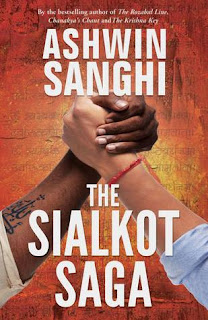Book summary: The Sialkot Saga

"The Sialkot Saga" is a fiction novel which is nicely setup within the various important events of Indian history shortly after independence in 1947. The author Ashwin Sanghi is one of the more respected Indian fiction author who has penned other notable works like "Chanakya's Chant" and "The Krishna Key". He is often regarded to be an Indian author in the league of Amish Tripathi. The book, "Sialkot Saga" is a decent enough and interesting read for anyone who is familiar with the Indian history from the time of independence in 1947 till 2010.
The book starts between the mass migration of Hindu and Sikh population from Pakistan to India in 1947, shortly after historic independence from British rule and a painful partition into nascent nation states India and Pakistan. A train consisting of Hindus and Sikhs from Sialkot in Pakistan is attacked and hacked brutally by Muslims. When the train reaches Amritsar on the Indian side it hardly had any anticipated survivors. A constable manages to pull out two kids from beneath the heaps of dead bodies of people who flee Pakistan. The author blends the story of these two kids with an ancient secret from emperor Ashoka's time when the emperor assigns the ownership of an important secret to one of his trusted gurus.
The story quickly moves to Bombay where the author tells the story of a young boy named Arbaaz Shiekh who is growing up in suburban Bombay with his parents. The author in parallel tells the story of Arvind Bagadia in Calcutta where Arvind learns the secrets of trading and entrepreneurship from his father. The author divides the book into six parts where each part tells the story of Arbaaz and Arvind as they transform their lives over each decade from 1950 to 2010. On one hand Arvind is a up coming businessman whose sole target in life is to appear in the top Indian businessmen list of Forbes magazine. His primary principle in life is to buy and sell businesses but not own a business of his own. Arbaaz on the other hand grows up into the mafia circle which is prominent in Bombay in 1960s. Arbaaz grows up under the leadership of Abdul Dada who is the undisputed underworld lead of Bombay. Arbaaz helps expand Abdul Dada's illegitimate businesses in Bombay with his shrewd mind and uncanny tricks.
As the businesses and reputation of Arvind grows with time and as Arbaaz's mafia clout grows in Bombay and elsewhere, both Arvind and Arbaaz clash with each other at different times in the book. Both develop an unhealthy competitive spirit towards each other and make every attempt to harm each other's businesses. The author has used the various important events in Indian history like the Indo-Chinese war of 1962, the wars with Pakistan in 1965 and 1971-72, the national emergency of 1975-77, the Hawla scam in Bombay stack exchange, the Bombay blasts of 1993, the 9/11 terrorists attacks on World Trade Center in 2001 and the Mumbai attacks in 2008 and how these events influence the lives of Arvind and Arbaaz.
The book becomes a little bit of drag towards the second half where the author struggles to keep novelty that he refreshingly portrays in the first half of the book. But the towards the end of the book the author was able to revive the novelty by providing a heart wrenching story behind the survival of the two little boys in the train from Sialkot and how the ancient secret carried through by generations of king Ashoka played a significant part in the entire story. The author was able to finish the novel on a high even though the end of the story was not happy. On the whole the novel is a decent read and recommended for people who are familiar with important events in Indian history.


Comments
Post a Comment